Improving the Estimation Accuracy of Soil Organic Matter Content Based on the Spectral Reflectance from Soils with Different Grain Sizes
Abstract
:1. Introduction
2. Materials and Methods
2.1. Data Acquisition
2.2. Spectral Feature Extraction
2.3. Model Construction
2.4. Model Evaluation Indices
3. Results
3.1. Descriptive Analysis of SOM
3.2. Spectral Reflectance of Soils with Different Grain Sizes
3.3. Correlations between Soil Spectral Reflectance and SOM Content
3.4. Model Construction and Evaluation
3.4.1. PLSR Model
3.4.2. SVM Model
3.4.3. RF Model
3.4.4. XGBoost Model
4. Discussion
5. Conclusions
- (1)
- The smaller the soil grain size, the higher the spectral reflectance. In the original spectral reflectance curve, the wavebands sensitive to SOM were primarily found within the 350–550 nm range (r > 0.5, p < 0.01), exhibiting a negative correlation with SOM content.
- (2)
- The spectral reflectance of the 0.85 mm sieved soil demonstrated relatively higher correlation coefficients with SOM content than the 0.25 mm sieved soil.
- (3)
- The mathematical transformation of original spectral reflectance of soil can effectively enhance the spectral characteristics related to the SOM content, and soil grain size obviously effect the accuracy of hyperspectral estimation model of SOM content.
- (4)
- The overall estimation accuracy and stability of the constructed hyperspectral estimation models in this study can be ranked as: RF > SVM > PLSR > XGBoost. The RF model had a significantly higher R2 and RPD value and relatively lower RMSE values compared with the PLSR, SVM, and XGBoost models. The 0.85 mm-RMSFD-RF method (R2 = 0.82, RMSE = 2.37, RPD = 2.27) was selected as the best model for estimating SOM content of farmland soil in the ILIA.
Author Contributions
Funding
Data Availability Statement
Conflicts of Interest
References
- Bai, Y.; Yang, W.; Wang, Z.; Cao, Y.; Li, M. Improving the estimation accuracy of soil organic matter based on the fusion of near-infrared and Raman spectroscopy using the outer-product analysis. Comput. Electron. Agric. 2024, 219, 108760. [Google Scholar] [CrossRef]
- Chen, Y.; Wang, J.; Liu, G.; Yang, Y.; Liu, Z.; Deng, H. Hyperspectral estimation model of forest soil organic matter in northwest Yunnan Province, China. Forests 2019, 10, 217. [Google Scholar] [CrossRef]
- He, Y.; Yang, M.; Huang, R.; Wang, Y.; Ali, W. Soil organic matter and clay zeta potential influence aggregation of a clayey red soil (Ultisol) under long-term fertilization. Sci. Rep. 2021, 11, 20498. [Google Scholar] [CrossRef] [PubMed]
- Zhao, L.; Fang, Q.; Hong, H.; Algeo, T.J.; Lu, A.; Yin, K.; Wang, C.; Liu, C.; Chen, L.; Xie, S. Pedogenic-weathering evolution and soil discrimination by sensor fusion combined with machine-learning-based spectral modeling. Geoderma 2022, 409, 115648. [Google Scholar] [CrossRef]
- Li, H.; Ju, W.L.; Song, Y.M.; Cao, Y.Y.; Yang, W.; Li, M.Z. Soil organic matter content prediction based on two-branch convolutional neural network combining image and spectral features. Comput. Electron. Agric. 2024, 217, 108561. [Google Scholar] [CrossRef]
- Hong, Y.S.; Chen, S.C.; Zhang, Y.; Chen, Y.Y.; Yu, L.; Liu, Y.F.; Liu, Y.L.; Cheng, H.; Liu, Y. Rapid identification of soil organic matter level via visible and near-infrared spectroscopy: Effects of two-dimensional correlation coefficient and extreme learning machine. Sci. Total Environ. 2018, 644, 1232–1243. [Google Scholar] [CrossRef]
- Six, J.; Paustian, K. Aggregate-associated soil organic matter as an ecosystem property and a measurement tool. Soil Biol. Biochem. 2014, 68, 4–9. [Google Scholar] [CrossRef]
- Keesstra, S.; Pereira, P.; Novara, A.; Brevik, E.C.; Azorin-Molina, C.; Parras-Alcántara, L.; Jordan, A.; Cerda, A. Effects of soil management techniques on soil water erosion in apricot orchards. Sci. Total Environ. 2016, 357, 551–552. [Google Scholar] [CrossRef]
- Xayida, S.; Mamattursun, E.; Zhong, Q.; Li, X.G. Estimating the chromium concentration of farmland soils in an arid zone from hyperspectral reflectance by using partial least squares regression methods. Ecol. Indic. 2024, 161, 111987. [Google Scholar]
- Jiang, X.Q.; Luo, S.J.; Ye, Q.; Li, X.C.; Jiao, W.H. Hyperspectral estimates of soil moisture content incorporating harmonic indicators and machine learning. Agriculture 2022, 12, 1188. [Google Scholar] [CrossRef]
- Jiang, X.F.; Duan, H.C.; Liao, J.; Guo, P.L.; Huang, C.H.; Xue, X.A. Estimation of soil salinization by machine learning algorithms in different arid regions of northwest China. Remote Sens. 2022, 14, 347. [Google Scholar] [CrossRef]
- Lin, L.X.; Gao, L.P.; Xue, F.C.; Wang, X.Y.; Zhang, S.R. Hyperspectral analysis of total nitrogen in soil using a synchronized decoloring fuzzy measured value method. Soil Till. Res. 2020, 202, 104658. [Google Scholar] [CrossRef]
- Wang, Y.; Zhang, X.; Sun, W.; Wang, J.; Ding, S.; Liu, S. Effects of hyperspectral data with different spectral resolutions on the estimation of soil heavy metal content: From ground-based and airborne data to satellite-simulated data. Sci. Total Environ. 2022, 838, 156129. [Google Scholar] [CrossRef] [PubMed]
- Ye, M.; Zhu, L.; Li, X.; Ke, Y.; Huang, Y.; Chen, B.; Yu, H.; Li, H.; Feng, H. Estimation of the soil arsenic concentration using a geographically weighted XGBoost model based on hyperspectral data. Sci. Total Environ. 2023, 858, 159798. [Google Scholar] [CrossRef] [PubMed]
- Shabtai, I.A.; Wilhelm, R.C.; Schweizer, S.A.; Höschen, C.; Buckley, D.H.; Lehmann, J. Calcium promotes persistent soil organic matter by altering microbial transformation of plant litter. Nature Commun. 2023, 14, 6609. [Google Scholar] [CrossRef] [PubMed]
- Khosravi, V.; Ardejani, F.D.; Yousefi, S.; Aryafar, A. Monitoring soil lead and zinc contents via combination of spectroscopy with extreme learning machine and other data mining methods. Geoderma 2018, 318, 29–41. [Google Scholar] [CrossRef]
- Wei, L.; Yuan, Z.; Wang, Z.; Zhao, L.; Zhang, Y.; Lu, X.; Cao, L. Hyperspectral inversion of soil organic matter content based on a combined spectral index model. Sensors 2020, 20, 2777. [Google Scholar] [CrossRef] [PubMed]
- Xu, S.X.; Wang, M.Y.; Shi, X.Z.; Yu, Q.B.; Zhang, Z.Q. Integrating hyperspectral imaging with machine learning techniques for the high-resolution mapping of soil nitrogen fractions in soil profiles. Sci. Total Environ. 2021, 754, 142135. [Google Scholar] [CrossRef] [PubMed]
- Ma, C.; Shen, G.; Wang, Z.; Wang, Z. Analysis of spectral characteristics for different soil particle sizes. Chin. J. Soil Sci. 2015, 46, 292–298. (In Chinese) [Google Scholar]
- Sadeghi, M.; Babaeian, E.; Tuller, M.; Jones, S.B. Particle size effects on soil reflectance explained by an analytical radiative transfer model. Remote Sens. Environ. 2018, 210, 375–386. [Google Scholar] [CrossRef]
- An, X.; Li, M.; Zheng, L.; Hong, S. Eliminating the interference of soil moisture and particle size on predicting soil total nitrogen content using a NIRS-based portable detector. Comput. Electron. Agric. 2015, 112, 47–53. [Google Scholar] [CrossRef]
- Bao, Y.; He, Y.; Fang, H.; Annia, G.P. Spectral characterization and N content prediction of soil with different particle size and moisture content. Spectro. Spec. Anal. 2007, 27, 62. [Google Scholar]
- Si, H.; Yao, Y.; Wang, D.; Liu, Y. Influence of soil particle size on the estimate of soil organic matter by hyperspectral spectroscopy. Chin. Agric. Sci. Bullet. 2015, 31, 173–178. (In Chinese) [Google Scholar]
- Muyassar, M.; Mamattursun, E.; Wang, L.L.; Xayida, S.; Wang, N.; Hu, Y.L. Pollution and ecological risk assessment of metal elements in groundwater in the Ibinur Lake Basin of NW China. Water 2023, 15, 4071. [Google Scholar] [CrossRef]
- NY/T 395—2000; Procedural Regulations Regarding the Environment Quality Monitoring of Soil. Standards Press of China: Beijing, China, 2000. (In Chinese)
- NY/T 1121.6—2006; Soil Testing–Part 6: Method for Determination of Soil Organic Matter. Standards Press of China: Beijing, China, 2006. (In Chinese)
- Wei, L.; Zhang, Y.; Lu, Q.; Yuan, Z.; Li, H.; Huang, Q. Estimating the spatial distribution of soil total arsenic in the suspected contaminated area using UAV-Borne hyperspectral imagery and deep learning. Ecol. Indic. 2021, 133, 108384. [Google Scholar] [CrossRef]
- Savitzky, A.; Golay, M.J. Smoothing and differentiation of data by simplified least squares procedures. Anal. Chem. 1964, 36, 1627–1639. [Google Scholar] [CrossRef]
- Zhong, Q.; Eziz, M.; Sawut, R.; Ainiwaer, M.; Li, H.; Wang, L. Application of a hyperspectral remote sensing model for the inversion of nickel content in urban soil. Sustainability 2023, 15, 13948. [Google Scholar] [CrossRef]
- Cao, X.; Zhang, J.; Meng, H.; Lai, Y.; Xu, M. Remote sensing inversion of water quality parameters in the Yellow River Delta. Ecol. Indic. 2023, 155, 110914. [Google Scholar] [CrossRef]
- Pal, M.; Foody, G.M. Feature selection for classification of hyperspectral data by SVM. IEEE Trans. Geosci. Remote Sens. 2010, 48, 2297–2307. [Google Scholar] [CrossRef]
- Elfatih, M.A.; Onisimo, M.; Elhadi, A.; Riyad, I. Detecting Sirex noctilio grey-attacked and lightning-struck pine trees using airborne hyperspectral data, random forest and support vector machines classifiers. ISPRS J. Photo. Remote Sens. 2014, 88, 48–59. [Google Scholar]
- Jia, Y.; Jin, S.G.; Savi, P.; Gao, Y.; Tang, J.; Chen, Y.X.; Li, W.M. GNSS-R soil moisture retrieval based on a XGboost machine learning aided method: Performance and validation. Remote Sens. 2019, 11, 1655. [Google Scholar] [CrossRef]
- Liu, W.; Li, M.; Zhang, M.; Long, S.; Guo, Z.; Wang, H.; Li, W.; Wang, D.; Hu, Y.; Wei, Y.; et al. Hyperspectral inversion of mercury in reed leaves under different levels of soil mercury contamination. Environ. Sci. Pollut. Res. Inter. 2020, 27, 22935–22945. [Google Scholar] [CrossRef] [PubMed]
- Sun, Y.S.; Chen, S.S.; Dai, X.M.; Li, D.; Jiang, H.; Jia, K. Coupled retrieval of heavy metal nickel concentration in agricultural soil from spaceborne hyperspectral imagery. J. Hazard. Mater. 2023, 446, 130722. [Google Scholar] [CrossRef] [PubMed]
- Vohland, M.; Besold, J.; Hill, J.; Fründ, H.C. Comparing different multivariate calibration methods for the determination of soil organic carbon pools with visible to near infrared spectroscopy. Geoderma 2011, 166, 198–205. [Google Scholar] [CrossRef]
- Summers, D.; Lewis, M.; Ostendorf, B.; Chittleborough, D. Visible near-infrared reflectance spectroscopy as a predictive indicator of soil properties. Ecol. Indic. 2011, 11, 123–131. [Google Scholar] [CrossRef]
- Bian, Z.J.; Sun, L.N.; Tian, K.; Liu, B.L.; Huang, B.; Wu, L.H. Estimation of multi-media metal(loid)s around abandoned mineral processing plants using hyperspectral technology and extreme learning machine. Environ. Sci. Pollut. Res. 2023, 30, 19495–19512. [Google Scholar] [CrossRef] [PubMed]
- Dai, X.; Liu, S.; Xiang, T.; Fu, T.; Feng, H.; Xiao, L.; Wang, Z.; Yao, Y.; Zhao, R.; Yang, X. Hyperspectral imagery reveals large spatial variations of heavy metal content in agricultural soil: A case study of remote-sensing inversion based on Orbita hyperspectral satellites (OHS) imagery. J. Clean. Product. 2022, 380, 134878. [Google Scholar] [CrossRef]
- Fang, S.; Yang, M.; Zhao, X.; Guo, X. Spectral characteristics and quantitative estimation of SOM in red soil typical of Ji’an County, Jiangxi Province. Acta Pedo. Sin. 2014, 51, 1003–1010. (In Chinese) [Google Scholar]
- Zheng, G.H.; Ryu, D.R.; Jiao, C.X.; Hong, C.Q. Estimation of organic matter content in coastal soil using reflectance spectroscopy. Pedosphere 2016, 26, 130–136. [Google Scholar] [CrossRef]
- Zhang, S.; Lu, X.; Nie, G.G.; Li, Y.R.; Shao, Y.T.; Tian, Y.Q.; Fan, L.Q.; Zhang, Y.J. Estimation of soil organic matter in coastal wetlands by SVM and BP based on hyperspectral remote sensing. Spectro. Spec. Anal. 2020, 40, 556–561. [Google Scholar]
- Zhou, Q.; Ding, J.L.; Ge, X.Y.; Li, K.; Zhang, Z.O.; Gu, Y.S. Estimation of soil organic matter in the Ogan-Kuqa River Oasis, Northwest China, based on visible and near-infrared spectroscopy and machine learning. J. Arid Land 2023, 15, 19–204. [Google Scholar] [CrossRef]
- Tan, K.; Wang, H.; Chen, L.; Du, Q.; Du, P.; Pan, C. Estimation of the spatial distribution of heavy metal in agricultural soils using airborne hyperspectral imaging and random forest. J. Hazard. Mater. 2020, 382, 120987. [Google Scholar] [CrossRef] [PubMed]
- Wu, H.Q.; Fan, Y.M.; He, J.; Jin, G.L.; Xie, Y.; Chai, D.P.; He, L. Response of soil hyperspectral characteristics of different particle sizes to soil. Acta Agrestia Sin. 2014, 22, 266. [Google Scholar]
- Yang, P.; Hu, J.; Hu, B.; Luo, D.; Peng, J. Estimating soil organic matter content in desert areas using in situ hyperspectral data and feature variable selection algorithms in southern Xinjiang, China. Remote Sens. 2022, 14, 5221. [Google Scholar] [CrossRef]
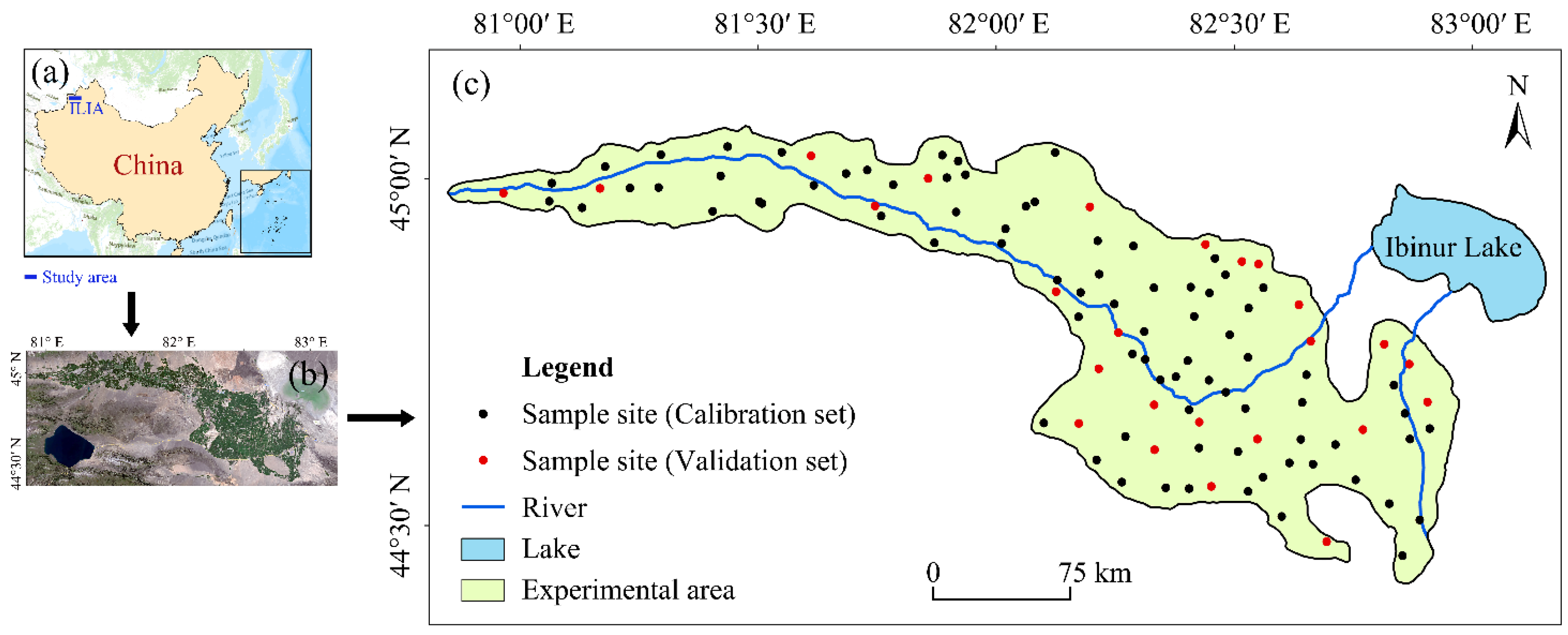

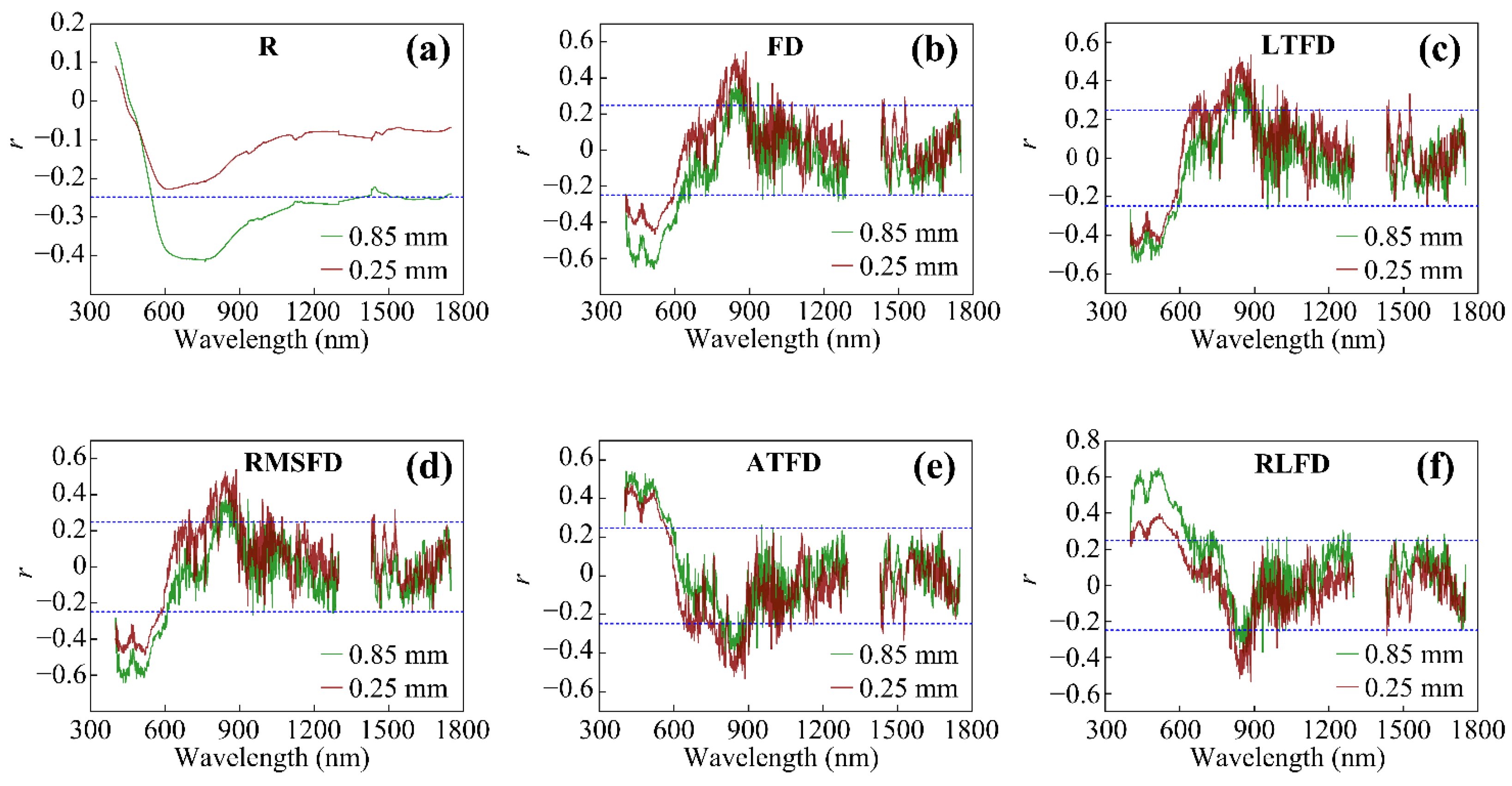

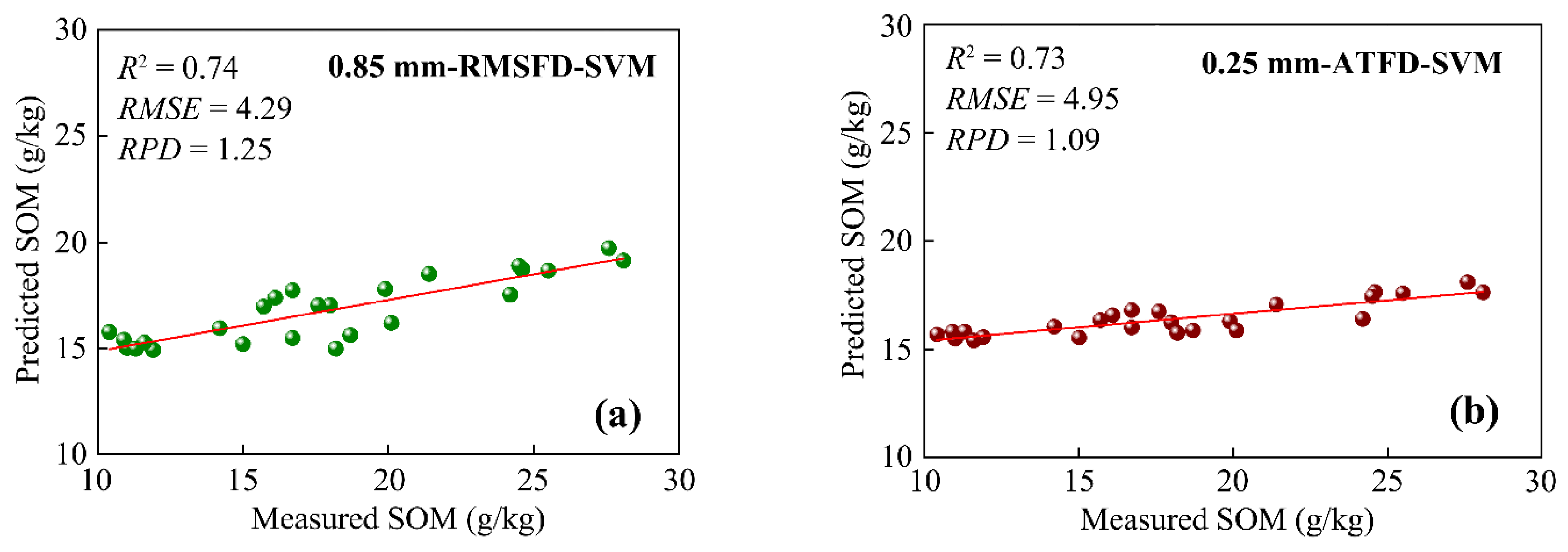
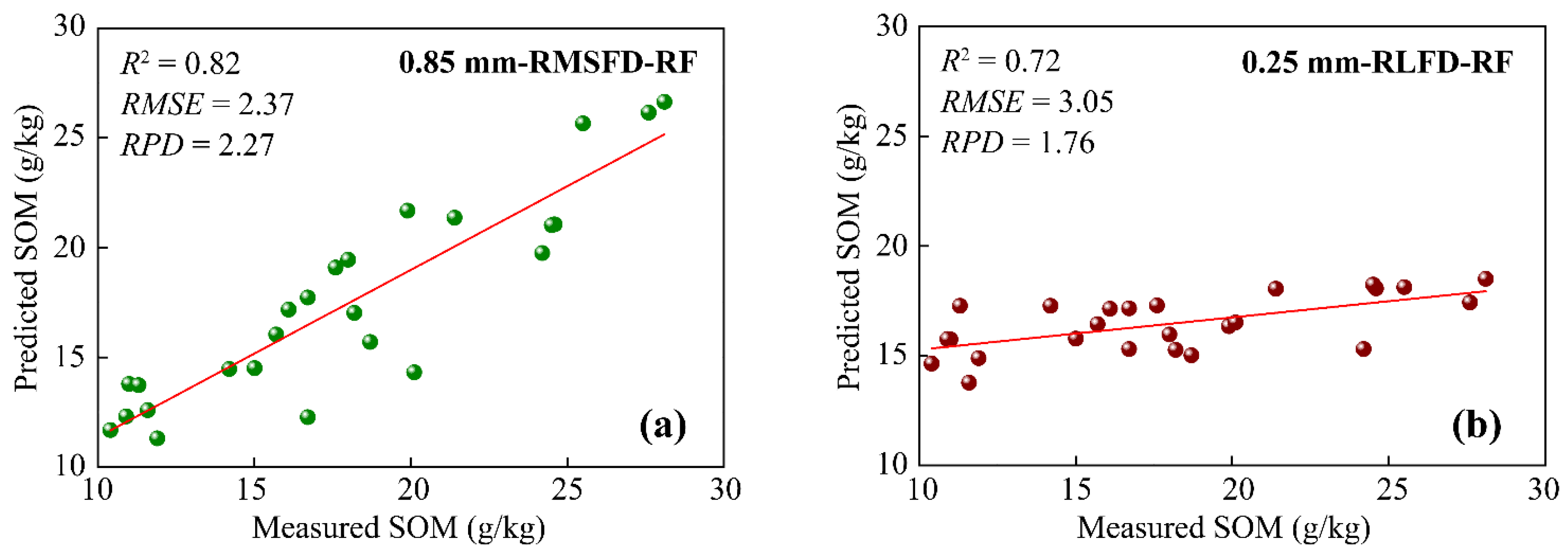

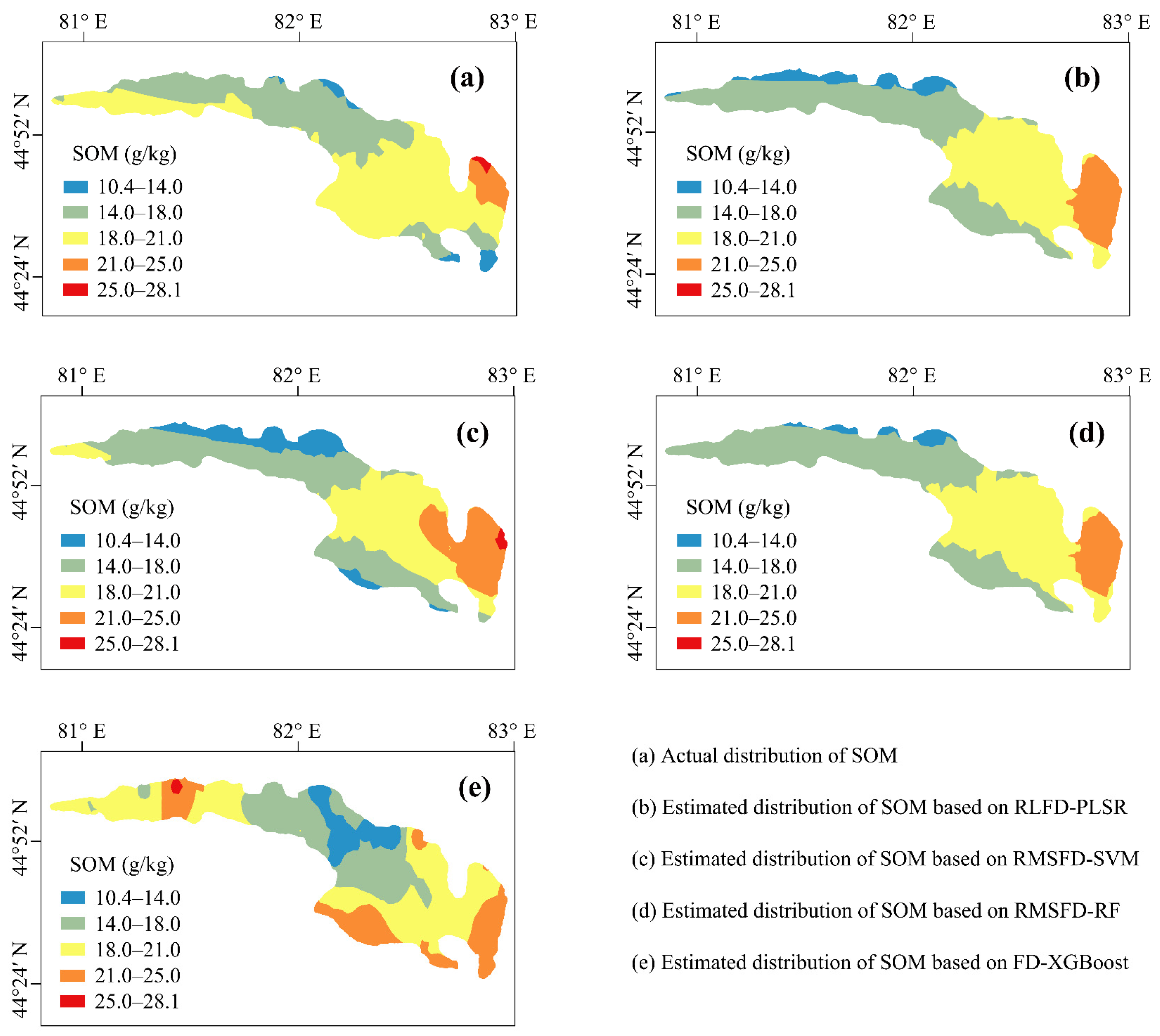
| Sample Type | n | SOM | pH | Salt (g/kg) | EC (us/cm) | |||
|---|---|---|---|---|---|---|---|---|
| Range (g/kg) | Average (g/kg) | S.D (g/kg) | CV (%) | |||||
| Calibration set | 81 | 6.04–31.60 | 16.94 | 4.99 | 29.48 | 8.84 | 0.39 | 1368.42 |
| Validation set | 25 | 10.40–28.10 | 17.96 | 5.38 | 29.94 | 8.88 | 0.45 | 1639.28 |
| Total set | 106 | 6.04–31.60 | 17.18 | 5.22 | 30.39 | 8.85 | 0.40 | 1432.30 |
| Models | Indices | The 0.85 mm Sieved Soil | The 0.25 mm Sieved Soil | ||||||||
|---|---|---|---|---|---|---|---|---|---|---|---|
| FD | LTFD | RMSFD | ATFD | RLFD | FD | LTFD | RMSFD | ATFD | RLFD | ||
| PLSR | R² | 0.56 | 0.61 | 0.59 | 0.54 | 0.62 | 0.41 | 0.44 | 0.40 | 0.44 | 0.48 |
| RMSE | 3.55 | 3.51 | 3.48 | 3.74 | 3.40 | 4.11 | 4.08 | 4.16 | 4.08 | 3.90 | |
| RPD | 1.52 | 1.53 | 1.55 | 1.44 | 1.58 | 1.31 | 1.32 | 1.29 | 1.32 | 1.38 | |
| SVM | R² | 0.70 | 0.64 | 0.74 | 0.63 | 0.69 | 0.44 | 0.73 | 0.62 | 0.73 | 0.38 |
| RMSE | 4.17 | 4.58 | 4.29 | 4.54 | 4.22 | 4.93 | 4.96 | 4.83 | 4.95 | 4.91 | |
| RPD | 1.29 | 1.17 | 1.25 | 1.19 | 1.27 | 1.09 | 1.08 | 1.11 | 1.09 | 1.10 | |
| RF | R² | 0.74 | 0.64 | 0.82 | 0.59 | 0.75 | 0.58 | 0.55 | 0.60 | 0.44 | 0.72 |
| RMSE | 2.97 | 3.62 | 2.37 | 3.41 | 3.00 | 3.53 | 3.71 | 3.62 | 4.07 | 3.05 | |
| RPD | 1.81 | 1.49 | 2.27 | 1.58 | 1.79 | 1.52 | 1.45 | 1.49 | 1.32 | 1.76 | |
| XGBoost | R² | 0.39 | 0.28 | 0.37 | 0.13 | 0.37 | 0.10 | 0.10 | 0.03 | 0.06 | 0.21 |
| RMSE | 3.76 | 3.52 | 3.79 | 3.81 | 4.16 | 4.54 | 4.53 | 5.21 | 3.78 | 4.45 | |
| RPD | 1.43 | 1.53 | 1.42 | 1.41 | 1.29 | 1.19 | 1.19 | 1.03 | 1.42 | 1.21 | |
Disclaimer/Publisher’s Note: The statements, opinions and data contained in all publications are solely those of the individual author(s) and contributor(s) and not of MDPI and/or the editor(s). MDPI and/or the editor(s) disclaim responsibility for any injury to people or property resulting from any ideas, methods, instructions or products referred to in the content. |
© 2024 by the authors. Licensee MDPI, Basel, Switzerland. This article is an open access article distributed under the terms and conditions of the Creative Commons Attribution (CC BY) license (https://creativecommons.org/licenses/by/4.0/).
Share and Cite
Subi, X.; Eziz, M.; Wang, N. Improving the Estimation Accuracy of Soil Organic Matter Content Based on the Spectral Reflectance from Soils with Different Grain Sizes. Land 2024, 13, 1111. https://doi.org/10.3390/land13071111
Subi X, Eziz M, Wang N. Improving the Estimation Accuracy of Soil Organic Matter Content Based on the Spectral Reflectance from Soils with Different Grain Sizes. Land. 2024; 13(7):1111. https://doi.org/10.3390/land13071111
Chicago/Turabian StyleSubi, Xayida, Mamattursun Eziz, and Ning Wang. 2024. "Improving the Estimation Accuracy of Soil Organic Matter Content Based on the Spectral Reflectance from Soils with Different Grain Sizes" Land 13, no. 7: 1111. https://doi.org/10.3390/land13071111





